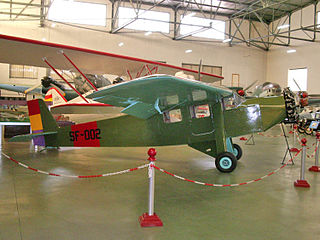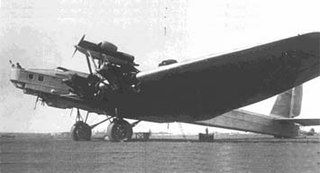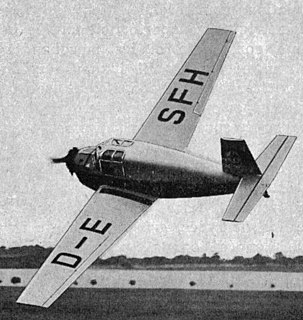
The Focke-Wulf Fw 189 Uhu is a German twin-engine, twin-boom, three-seat tactical reconnaissance and army cooperation aircraft. It first flew in 1938, entered service in 1940 and was produced until mid-1944.
The Abrams Air Craft Corporation was an aircraft manufacturer established in Lansing, Michigan, USA, in 1937 as an offshoot of Talbert Abrams' Aerial Survey Corporation. Abrams had founded an airline in 1929 but found himself increasingly interested in aerial photography. The new company was created for the purpose of designing and producing a dedicated survey aircraft. The result was the P-1 Explorer, designed by Abrams with assistance from Kenneth Ronan of Ronan & Kunzl.

The RWD-10 was a Polish aerobatics sports plane, single-seat parasol wing monoplane, used from 1933 to 1939 and constructed by the RWD team.

The Aviat Husky is a tandem two-seat, high-wing, utility light aircraft built by Aviat Aircraft of Afton, Wyoming.

The Farman F 400 was a 1930s French three-seat cabin high-winged monoplane which was designed and built by Farman.

The RWD 9 was a Polish sports plane of 1934, constructed by the RWD team.

The PWS-24 was a Polish single-engine passenger aircraft for 4 passengers, built in PWS factory, used from 1933 to 1936 by LOT Polish Airlines. In spite of its limited capacity, it was the only series-built airliner of domestic design ever used by the LOT.

The PZL.44 Wicher (gale) was a prototype of 14-seat, twin-engine Polish airliner, built in the Państwowe Zakłady Lotnicze (PZL) in 1938. It was to compete with the DC-2 and Lockheed Super Electra.

The BAT F.K.23 Bantam was a British single-seat fighter biplane produced by British Aerial Transport Company Limited of London during World War I.

The Meyers OTW was a 1930s United States training biplane designed by Allen Meyers and built by his Meyers Aircraft Company from 1936 to 1944.

The AeroVironment FQM-151 Pointer is a small UAV used by the United States Army and Marine Corps for battlefield surveillance. It was designed by AeroVironment Incorporated, which is run by Paul MacCready, noted for such pioneering aircraft as the human-powered Gossamer Condor and a robotic flying pterodactyl replica. The Pointer was developed with company funds, with the US Army and Marine Corps obtaining a total of about 50 beginning in 1990.

The Potez 32 and its military version the Potez 33 was a single-engine French monoplane transport built by Potez and based on the Potez 29 biplane.

The Tupolev ANT-16 was an experimental heavy bomber aircraft designed and tested in the Soviet Union in the early 1930s.

The Siebel Si 202 Hummel ("Bumble-bee") was a German light sportsplane of the late 1930s. It was an angular low-wing monoplane, which could be powered by a variety of small engines.

The InterPlane Skyboy is a two-seat, side-by-side, high wing, single engine, pusher configuration ultralight aircraft that was manufactured as a completed aircraft by InterPlane Aircraft of Zbraslavice, Czech Republic.

The PWS-4 was a prototype Polish sports aircraft, developed in 1928 by Podlaska Wytwórnia Samolotów.
The Kinetic Mountain Goat is an American two-seat cabin monoplane, designed by Bill Montagne for his company Kinetic Aviation.
The Comte AC-11-V was a 1930s Swiss three-seat cabin monoplane produced by Flugzeugbau A. Comte for aerial photography and mapping. The AC-11-V was a high-wing monoplane with a taikskid-conventional landing gear and powered by a 220 hp (164 kW) Armstrong Siddeley Lynx radial engine.

The Historical Ryan STA was an American homebuilt aircraft that was designed and produced by the Historical Aircraft Corporation of Nucla, Colorado. The aircraft was an 85% scale replica of the original Ryan STA and when it was available was supplied as a kit for amateur construction.
The Aerial Service Mercury Senior, Aerial Mercury Senior or just Mercury Senior was a US biplane mailplane designed to operate at night between New York City and Chicago. A different, smaller, lower wing improved its performance for daytime flights. One was built and used by the United States Post Office Department.

















